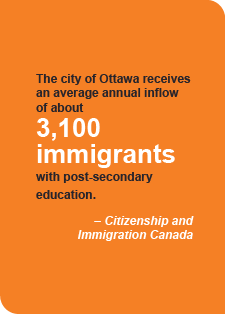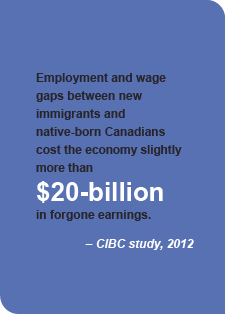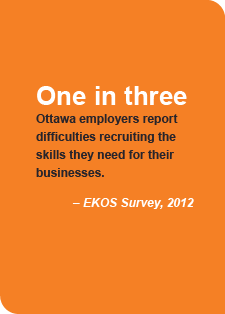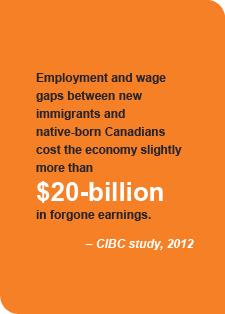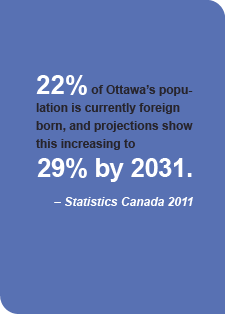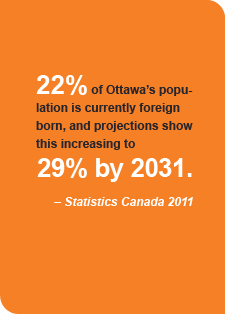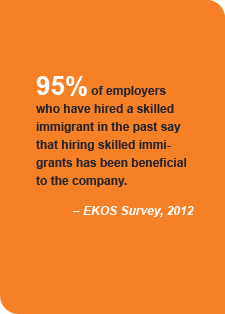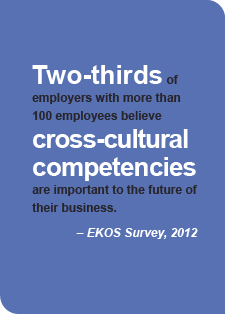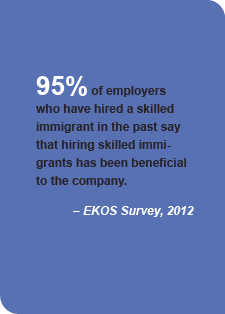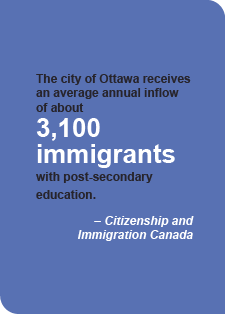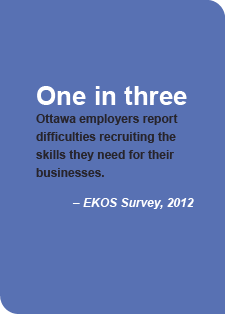Hiring: Overqualification and the Law
Being skilled or educated beyond what is necessary for a job — in other words, being overqualified — is an important issue for jobseekers, employers and policymakers. While it is sometimes a personal choice to work in a lower-skilled job, for most people who take jobs for which they are overqualified, it is their only employment option.
This scenario is especially so for Canada’s recent immigrants.
Recruiters typically screen out overqualified applicants because they believe such candidates will be experience dissatisfaction in their jobs and leave after a short period of time. Not only do two recent international studies demonstrate this perception is flawed, but in Canada, employers now have the law to consider when it comes to one segment of overqualified candidates — visible minority immigrants.
In 2006 the Canadian Human Rights Tribunal handed down a landmark ruling on the use of overqualification as a justification for rejecting candidates who are visible minority immigrants (Statistics Canada defines a recent immigrant as someone who has been a permanent resident for five to 10 years and a very recent immigrant as someone who has been here for less than five years). The case involved a complaint filed with the Canadian Human Rights Commission by Dr. Gian Sangha after he was rejected for the position of Regulatory Officer (RO) with the Mackenzie Valley Land and Water Board (MVLWB).
The MVLWB’s newspaper ad for four vacant RO positions outlined its requirements: a degree in a relevant field and two years of related experience, or a college diploma related to environmental management and three years of experience; knowledge of relevant technology and issues; software and technical writing competencies; and a driver’s licence. The positions were for three-year terms, subject to a six-month probationary period, with a possible two-year extension.
ROs carry out standardized administrative tasks such as processing land use permits and water licence applications. This involves collaborating with other stakeholders for review purposes and preparing reports for the Board. While ROs must have basic technical knowledge, more expertise is available internally or from external consultants. An understanding of the environmental issues in the north, as well as northern living experience and some familiarity with First Nations communities, were also considered important.
MVLWB’s interview committee (a finance/administration manager, a line manager and a technical person) interviewed 12 of its 38 applicants: two with college diplomas, nine with bachelor degrees and Dr. Sangha. Applicants with just a high school diploma and those with a graduate degree were not interviewed, indicating that education was used to screen out candidates both on the low side and the high side. However, unbeknownst to Dr. Sangha, he was interviewed because of his potential to fill the more senior position of Technical Advisor, which was also vacant at the time.
Avoiding personal characteristics such as race, ethnic origin, religion or age, the committee’s structured interview contained standard questions to explore skills, knowledge of the MVLWB, experience, availability and salary expectations. Dr. Sangha was ranked highest by the line manager and fourth by the finance/administration manager (the technical person did not provide scores).
In addition to the interview scores, the decision to make an offer was based on a candidate’s overall profile and whom the committee considered a good fit. The committee’s decision not to hire Dr. Sangha was based on the assessment that he was overqualified for the entry-level RO position and that he would be bored by the work. After offers to two other candidates were declined, the MVLWB hired two candidates who were ranked significantly lower than Dr. Sangha on the interview scores.
Employee turnover is a particular issue in Canada’s north, and it’s one of the reasons the MVLWB prefers northern experience. Ironically, it seems that the Board’s candidate selections failed to improve turnover. Most of the RO positions became vacant within three years, as the incumbents moved on to other opportunities or left the north. In Dr. Sangha’s case, his lack of northern experience was not the criterion on which his candidacy was rejected.
In considering the case, the Canadian Human Rights Tribunal said that for Dr. Sangha to prove discrimination, he had to show that he possessed the basic qualifications for the job; he is a visible minority immigrant; he is overqualified vis-à-vis the job in question; the overqualified status was one of the reasons why he was not hired; and there is a correlation between visible minority immigrant status and overqualified status.
The Tribunal easily found that Dr. Sangha had proven the first four points, and in bringing the case forward, the Canadian Human Rights Commission relied in large measure on opinions provided by Dr. Jeffrey Reitz, a University of Toronto professor who is an expert in the area of ethnic, immigration and pluralism studies. Dr. Reitz outlined several supporting conclusions about the immigrant labour market based on data from the Census and the Labour Force Survey:
Immigrants are, on average, more highly educated than native-born Canadians. Since the 1970s, most immigrants are visible minorities, and the largest segment of these are independent or economic immigrants, who are selected based on Canada’s points system. These immigrants tend to have some form of post-secondary education, and substantial numbers have not just university degrees, but also advanced degrees. Despite their education, visible minority immigrants face barriers to employment at their level of qualification, which forces them to seek lower-skilled jobs. These barriers include employers’ unfamiliarity with foreign qualifications, lack of credit for non-Canadian work experience, highly restrictive licensing processes, as well as discriminatory hiring practices based on race, immigrant status or origin.
Immigrants often accept work for which they are overqualified because they are denied employment at their level of qualification. Consequently, they are over-represented in lower-skilled jobs compared to Canadians with equivalent paper qualifications and under-represented in ”knowledge occupations,” where a high proportion of workers have a university education (for example, science, engineering, health and other professions).
Even though such occupations are increasing in importance along with the skill levels of immigrants, immigrant representation in these occupations has fallen in absolute terms.
Immigrants tend to come from countries with significantly less economic opportunities, and their point of comparison is the jobs held in their country of origin by comparatively qualified people. To the extent that turnover results from workers pursuing other opportunities, the barriers faced by immigrants eliminate these opportunities. In fact, turnover may be less of a problem among immigrant workers. The data indicate that overqualified job candidates are likely to be racial minority immigrants, which means that a policy of not hiring overqualified candidates results in screening out visible minority immigrants.
Based on Dr. Reitz’s expert testimony, the Tribunal found that there was a correlation “between visible minority immigrant status and overqualified status.” It substantiated Dr. Sangha’s complaint of discrimination under section 7 of the Canadian Human Rights Act. It issued the following order: “Where a visible minority immigrant has been chosen for an interview for a position with the MVLWB, that the MVLWB cease using any policy or practice that would automatically disqualify such candidate for the reason that they are overqualified for the job.”
The damages awarded by the Tribunal did not result in Dr. Sangha being hired as an RO or provide any payment for lost income. However, a subsequent request to federal court to grant a judicial review did find that the Tribunal erred in this regard. Stating there was significant evidence to suggest that Dr. Sangha did have a “serious possibility” of being hired, the federal court sent the case back to the Tribunal. The absence of further reporting on the case suggests that the parties reached an out-of-court settlement.
The findings of the Tribunal and Federal Court are now part of Canada’s body of case law, and have already been cited as precedent in a number of subsequent cases.
The Canadian Human Rights Commission considers this case a landmark ruling. The ruling also suggests that Canada’s labour law and human rights landscape is becoming more aligned with the shifting profile of our ethno-demographic landscape. Not only should employers be aware about the emerging legalities of the hiring process, they would also benefit from exploring the rich nature of the skilled immigrant labour pool.
A growing number of cities have immigrant employment councils as well as immigrant-serving agencies, which offer tremendous expertise on the process of recruiting and integrating skilled immigrants into the workforce. With this type of support, which employers can typically access at no cost, hiring skilled immigrants can be tremendously rewarding in developing a robust human resource strategy.
———
Authors
Raquel Chisholm, Senior Associate for Emond Harnden LLP
Emond Harnden LLP is Eastern Ontario’s largest law firm devoted exclusively to advising management on labour relations and employment matters. For more information, please visit www.emondharnden.com.
Michael Sebold, Senior Manager, Public Policy and Research for Hire Immigrants Ottawa
Visit our Tools and Resources page for complimentary employer-focused resources and tools to enhance your organization’s readiness to recruit and integrate internationally educated professionals.

